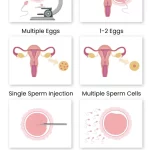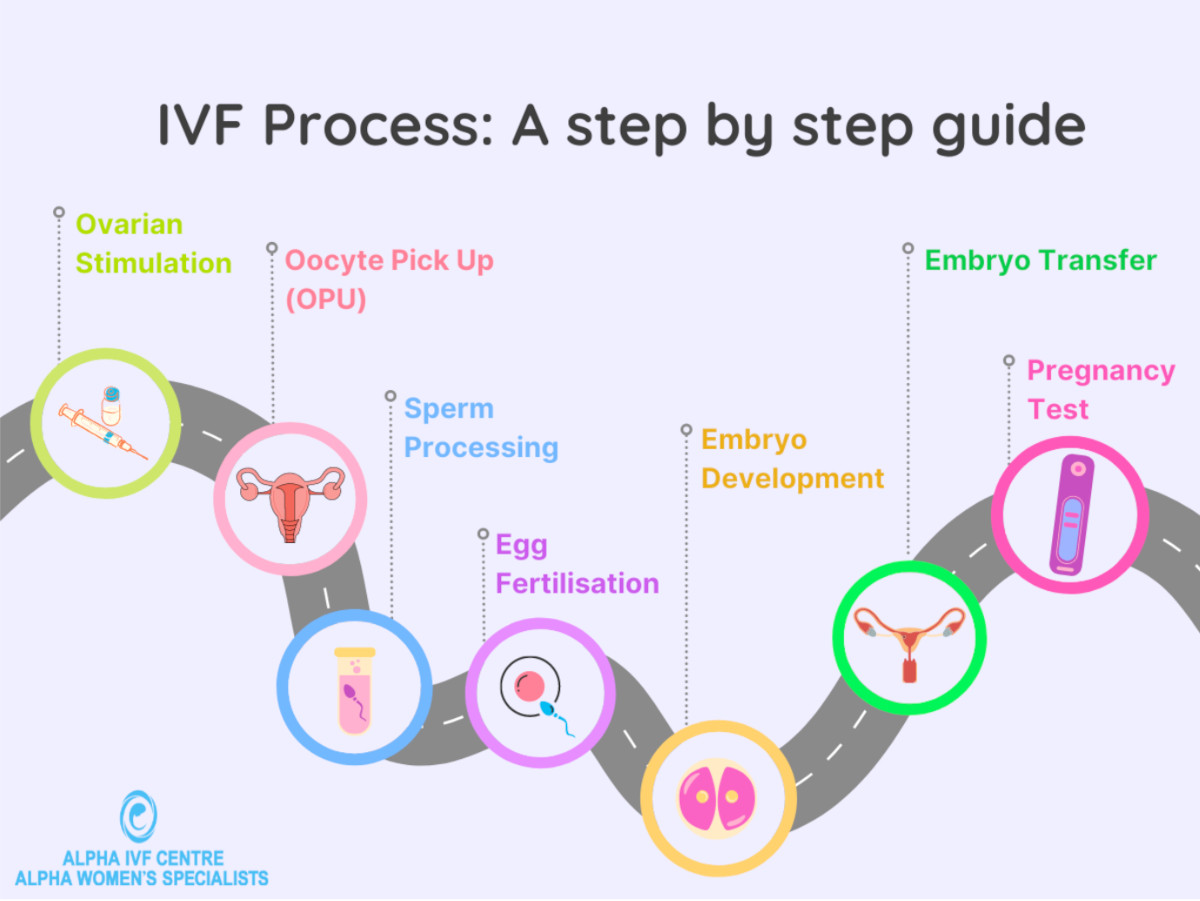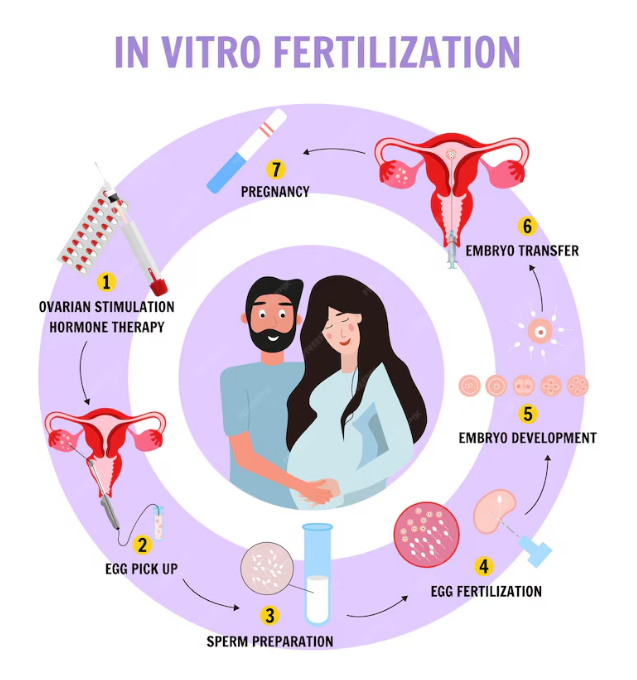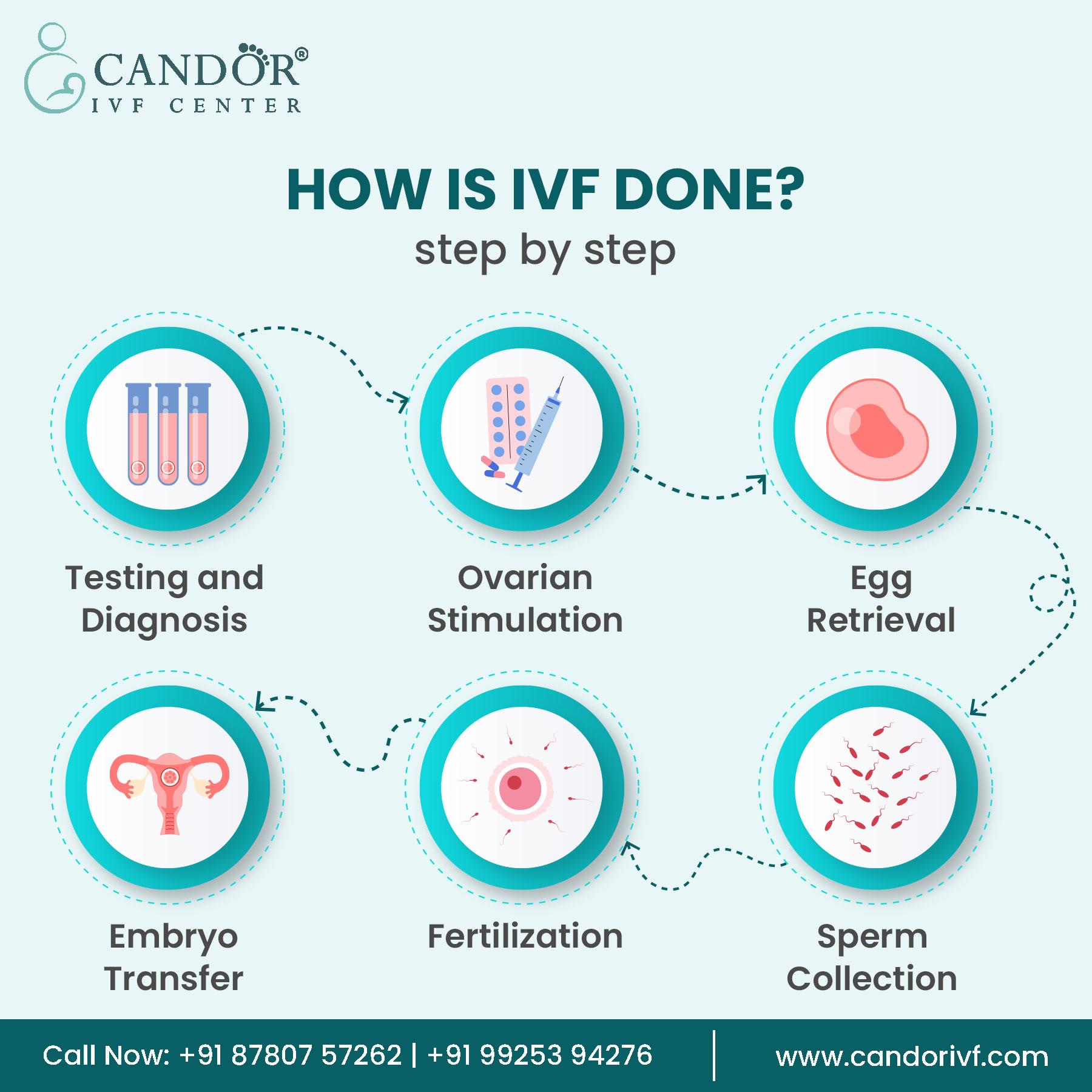
IVF Definition: Everything You Need to Know About In Vitro Fertilization
April 15, 2025IVF Process Step by Step: Your Ultimate Guide to the Journey
Hey there! If you’re reading this, you’re probably curious about in vitro fertilization (IVF)—maybe you’re thinking about it for yourself, or maybe you’re just fascinated by the science behind making a baby in a lab. Either way, you’re in the right place! IVF is like a rollercoaster ride: thrilling, a little scary, and full of twists you might not expect. In this guide, I’m going to walk you through every single step of the IVF process—super detailed, super clear, and with some fun, insider scoop that you won’t find just anywhere. We’ll cover the nitty-gritty, bust some myths, and sprinkle in the latest research to give you the full picture. Ready? Let’s dive in!

What Is IVF, Anyway?
IVF stands for in vitro fertilization, which is Latin for “fertilization in glass.” Cool, right? It’s a process where doctors take an egg and sperm, mix them together in a lab (not your body!), and then place the resulting embryo back into the uterus to grow into a baby. It’s like giving nature a little high-tech nudge when things don’t work out the old-fashioned way.
Why People Choose IVF
Couples (or even solo parents-to-be) turn to IVF for all sorts of reasons:
- Trouble getting pregnant after trying for a year or more.
- Blocked fallopian tubes (think of them as the highways for eggs).
- Low sperm count or sluggish swimmers.
- Just wanting to freeze eggs for later—like a fertility time capsule!
Fun fact: Over 8 million babies have been born through IVF since the first one, Louise Brown, arrived in 1978. That’s a lot of test-tube miracles!
A Peek Behind the Curtain
What’s wild is how emotional this journey can get. One mom I heard about kept a journal during her IVF cycle and said she felt like a “mad scientist and a hopeful dreamer” all at once. It’s not just medical—it’s personal, messy, and magical.

Step 1 – Getting Ready: The Prep Work
Before the IVF party starts, there’s some homework to do. This isn’t just popping a pill and crossing your fingers—it’s about setting the stage for success.
Doctor Visits and Tests
First up, you’ll meet with a fertility specialist. They’re like detectives, piecing together clues about why pregnancy hasn’t happened yet. Here’s what they’ll check:
- Blood tests: To measure hormone levels (like FSH and AMH) and see how your ovaries are doing.
- Ultrasound: A quick peek at your ovaries and uterus with a wand (yep, it goes inside, but it’s not as bad as it sounds).
- Semen analysis: For the guys, it’s a simple “sample in a cup” to check sperm health.
Real Talk: One couple said they were shocked to learn the guy’s love for hot tubs might’ve cooked his sperm a little. Who knew?
Lifestyle Tweaks
Your doc might suggest some changes to boost your odds:
✔️ Quit smoking—studies show it cuts IVF success rates by up to 30%.
✔️ Cut back on coffee (sorry, latte lovers).
✔️ Exercise, but not too much—think yoga, not marathons.
❌ Skip the late-night Netflix binges—sleep matters more than you think!
The Emotional Prep
This part’s sneaky but huge. IVF can feel like an emotional marathon. Some folks start journaling, others join support groups. One woman told me she knit tiny baby booties during this phase “just to keep my hands busy and my heart hopeful.”
Pro Tip: Ask your clinic about counseling—it’s often free and a game-changer.
Step 2 – Boosting Your Eggs: Ovarian Stimulation
Now the real action begins! Step 2 is all about getting your ovaries to produce more eggs than usual. Normally, you release one egg a month, but IVF wants a whole squad.
The Meds You’ll Take
You’ll start injections—yep, needles—for about 10-12 days. These are hormones like:
- FSH (Follicle-Stimulating Hormone): Tells your ovaries, “Hey, make more eggs!”
- LH (Luteinizing Hormone): Helps those eggs mature.
What It Feels Like: Some say it’s like a tiny pinch; others call it “a mosquito bite with attitude.” You’ll get used to it!
Fun Side Effects (Not Really)
Here’s the scoop nobody talks about:
- Bloating—like you ate a whole pizza.
- Mood swings—one minute you’re laughing, the next you’re crying over a dog commercial.
- Sore boobs—thanks, hormones!
One patient said, “I felt like a walking science experiment, but knowing it was for my baby kept me going.”
Monitoring the Magic
Every few days, you’ll visit the clinic for:
- Ultrasounds: To count and measure your growing follicles (egg sacs).
- Blood tests: To check hormone levels.
Latest Research: A 2023 study found that tweaking these meds based on your AMH levels can bump success rates by 10%. Cool, huh?
Action Step: Keep a calendar—those appointments pile up fast!
Step 3 – Egg Retrieval: The Big Pickup
This is the moment you’ve been prepping for: collecting those eggs! It’s a quick procedure, but it’s a big deal.
How It Goes Down
- You’ll be sedated (no pain, just a nice nap).
- The doctor uses a thin needle, guided by ultrasound, to suck the eggs out of your follicles through your vagina.
- It takes about 20-30 minutes, and you’re done!
Weird Fact: They might collect 5-20 eggs, but not all will be winners. Quality over quantity!
What You’ll Feel
Afterward, you might have:
- Cramping—like mild period pain.
- Spotting—totally normal.
- Sleepiness from the sedation.
Insider Tip: Bring a comfy blanket and a friend to drive you home. You’ll want to Netflix and chill all day.
The Sperm Side of Things
While you’re napping, your partner (or donor) provides a sperm sample. The lab washes it to pick the best swimmers—think of it like an Olympic tryout for sperm!
Step 4 – Fertilization: Making Embryos
This is where the magic happens—eggs meet sperm in a lab dish. It’s like a tiny blind date with a big outcome.
Two Ways to Fertilize
- Standard IVF: Eggs and sperm are mixed together and left to do their thing.
- ICSI (Intracytoplasmic Sperm Injection): One sperm is injected right into an egg—used if sperm are slow or few.
Did You Know?: ICSI is like a VIP pass for sperm—it’s boosted success rates for male infertility by 25% since the ‘90s.
Watching Embryos Grow
For 3-5 days, the embryos grow in an incubator. Scientists check them daily, looking for:
- Cell division (more cells = good!).
- Shape and symmetry—like judging a beauty pageant.
Unique Angle: Some clinics now use time-lapse cameras to spy on embryos 24/7. A 2024 study showed this ups the odds of picking a winner by 15%.
The Waiting Game
You won’t hear much during this phase—just a call to say how many embryos made it. One dad said, “It’s like waiting for a report card, but for your future kid!”
Pro Tip: Distract yourself—bake cookies, binge a show, anything but obsess!

Step 5 – Embryo Transfer: Back to You
Time to put those embryos where they belong—in your uterus! This step is quick but nerve-wracking.
The Procedure
- No sedation needed—just a full bladder (to help the ultrasound see better).
- A tiny catheter slides through your cervix and drops the embryo in.
- Takes 5-10 minutes, and you’re done!
What It’s Like: One woman said it felt like “a Pap smear with higher stakes.”
Fresh vs. Frozen
- Fresh Transfer: Happens 3-5 days after retrieval.
- Frozen Transfer: Embryos are frozen and transferred later—often more successful (up to 10% higher live birth rates, per 2022 data).
Why Freeze?: Gives your body a break from hormones and lets docs test embryos for genetic issues.
Aftercare
✔️ Rest for a day, but don’t become a couch potato—light walking is fine.
✔️ Take progesterone (pills or shots) to help the embryo stick.
❌ No hot tubs or heavy lifting—keep it chill!
Step 6 – The Two-Week Wait: Holding Your Breath
This is the longest 2 weeks of your life—waiting to see if the embryo implants and you’re pregnant.
What’s Happening Inside
The embryo is (hopefully) snuggling into your uterine lining. Your body starts making hCG—the pregnancy hormone—if it works.
How to Survive
- Distraction: Paint your nails, read a book, anything!
- Symptoms to Watch: Cramping, spotting, or sore boobs might hint at success—or just tease you.
- No Peeking: Skip home pregnancy tests—they can lie this early.
Real Story: One mom said she ate pineapple every day because she heard it helps implantation. Science says maybe (it’s got bromelain, which might reduce inflammation), but it’s mostly a cute superstition.
The Big Test
After 10-14 days, you’ll get a blood test at the clinic. It’s more accurate than a pee stick and tells you the hCG level.
Expert Quote: “The two-week wait is the hardest part emotionally,” says Dr. Jane Frederick, a fertility specialist. “Stay busy and lean on your support system.”
What Happens Next?
Pregnant? Not pregnant? Either way, there’s a next step.
If It’s a Yes
- Celebrate (quietly—you’re still early!).
- Ultrasounds start at 6-7 weeks to check the heartbeat.
- You’ll keep taking progesterone for a while.
Fun Fact: Twins happen in about 20% of IVF pregnancies—double the natural rate!
If It’s a No
- It sucks, no sugarcoating it. Take time to grieve.
- Talk to your doc—leftover frozen embryos mean another shot without starting over.
- New Research: A 2024 study found tweaking protocols after a failed cycle boosts success by 18% on round two.
Encouragement: One couple said their second try worked after the first flopped. “It’s not over till you say it is,” they told me.

Insider Secrets You Won’t Find Elsewhere
Let’s spill some tea—stuff that doesn’t always make it to the brochures.
The Cost Nobody Talks About
IVF isn’t cheap—$15,000-$20,000 per cycle in the U.S. But here’s the kicker:
- Meds can add $5,000 more.
- Freezing embryos? Another $1,000 a year.
- Some clinics offer refunds if it fails—ask about it!
Hack: Check fertility grants or crowdfunding—tons of couples raise cash this way.
Weird IVF Hobbies
People get creative waiting for results:
- Collecting lucky charms (one guy carried a four-leaf clover keychain).
- Naming embryos—think “Embry McEmbryo.”
- Planting “hope gardens” during the two-week wait.
The Latest Tech
- AI in Embryo Selection: Clinics are testing artificial intelligence to pick the best embryos—success rates jumped 12% in a 2023 trial.
- In Vitro Gametogenesis (IVG): Scientists are working on making eggs from skin cells. It’s years away, but mind-blowing!
Expert Quote: “AI is like having a super-smart embryologist who never sleeps,” says Dr. Amy Sparks, a reproductive tech researcher.
Boosting Your Chances: Practical Tips
Want to stack the deck in your favor? Here’s how.
Diet Do’s and Don’ts
✔️ Load up on antioxidants—berries, nuts, spinach.
✔️ Try a Mediterranean diet—fish, olive oil, veggies. A 2022 study linked it to 20% higher success.
❌ Skip processed junk—chips and soda mess with hormones.
Stress Busters
- Meditation: 10 minutes a day cuts cortisol (stress hormone) levels.
- Acupuncture: Some swear by it—research shows it might up implantation rates by 15%.
Partner Power
Guys, you’re in this too!
- Take zinc and vitamin C—sperm love it.
- Ditch tight undies—let those swimmers breathe.
Expert Quote: “Small changes in both partners can make a big difference,” says Dr. Mark Surrey, a fertility guru.
Myths vs. Facts: Clearing the Air
IVF comes with baggage—let’s unpack it.
Myth #1: IVF Guarantees a Baby
Fact: Nope. Success rates hover around 30-40% per cycle for women under 35, dropping as you age. It’s a chance, not a promise.
Myth #2: It’s Only for Women
Fact: Half the time, it’s a guy thing—sperm issues are just as common as egg probs.
Myth #3: IVF Babies Are Different
Fact: They’re just as healthy as natural babies. A 2023 study found no big differences in long-term health.
The Emotional Rollercoaster: Coping 101
IVF isn’t just shots and scans—it’s a heart thing too.
The Highs
- Seeing your embryos on a screen? Pure joy.
- That positive test? Tears and hugs galore.
The Lows
- Failed cycles sting—give yourself grace.
- Jealousy when friends announce pregnancies? Normal.
Survival Kit
- Support: Online forums like Reddit’s r/infertility are gold.
- Self-Care: Bubble baths, chocolate, whatever works.
- Talk: Tell your partner how you feel—they’re not mind readers!
Real Story: One woman said she and her husband watched funny movies every night of the two-week wait. “Laughter kept us sane,” she said.
